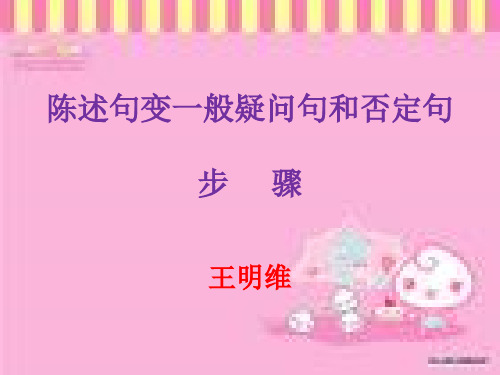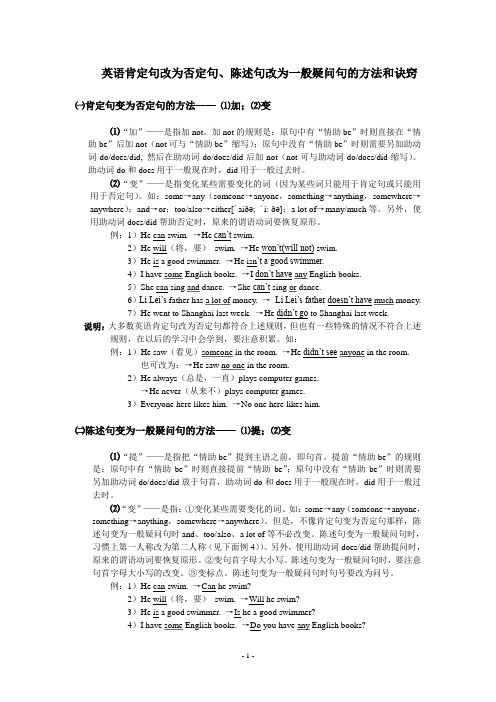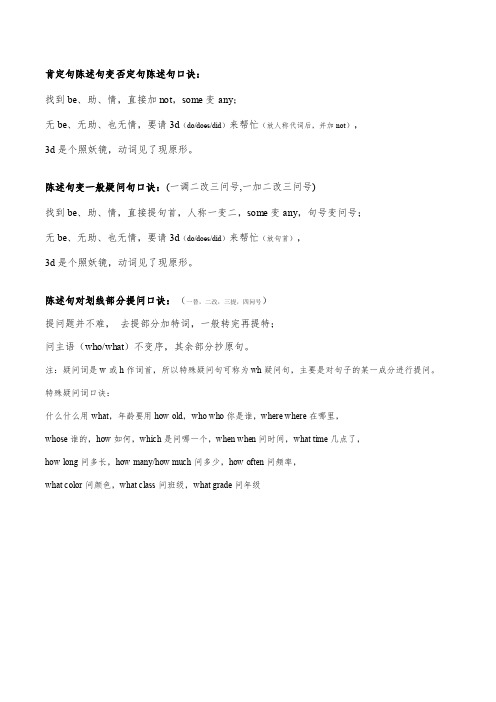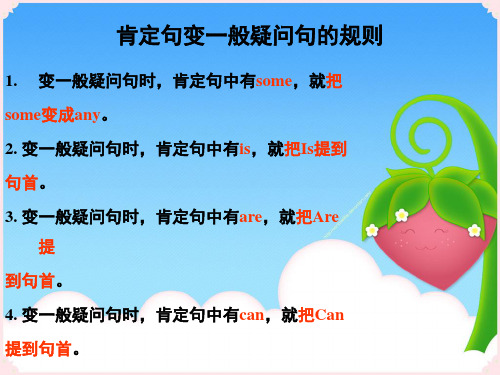陈述句变一般疑问句和肯定句变否定句的几点技巧
英语陈述句变一般疑问句 划线部分提问(特殊问句)归纳与总结

陈述句变一般疑问句1、首先看句子当中有没有be动词(am/is/are)或情态动词(can/will/would/should),如果有,则把他们提到句首;2、如果没有,则在句首加Do或Does(第三人称单数开头的一般现在时的句子用Does,并注意把谓语动词变为原形),3、一般疑问句的回答,肯定回答:Yes,主语代词+句首词.否定回答:No,主语代词+句首词与not的缩写形式。
2、四点注意:1、注意人称变化,2、注意大小写变化,3、注意标点符号的变化,4、注意把some变成any(would like句型除外)。
例:This is my pen.is 提到了句首第一人称变为第二人称,句号变为问号?一般疑问句:Is this your pen?肯定回答:Yes,this is. No,this isn’t.句首词主语代词句首词句首词和not的缩写例:Xiaoming goes to school by bike.分析:首先,句子当中没有be动词和情态动词,所以只能用Do或Does,因为主语Xiaoming 为第三人称单数,所以用Does,那么变为一般疑问句:Does Xiaoming go to schoo by bike? 肯定回答:Yes,he does. No,he doesn’t.句首词主语代词句首词句首词和not的缩写肯定句变否定句:首先看句子当中有没有be动词(am/is/are)或情态动词(can/will/would/should),如果有,则在他们后面加not;2、如果没有,则在主语后加Don”t或者Doesn’t(第三人称单数开头的一般现在时的句子用Doesn’t,并注意把谓语动词变为原形)对划线部分提问:1、首先看划线部分,根据划线部分的汉语意思判断特殊疑问词,并将特殊疑问词写在句首;2、然后把划线部分外的内容,变为一般疑问句,并写在特殊疑问词的后面。
3、注意:询问职业的用What do/does 人do? 或者What is/are 人称所有格job?询问爱好的用What is/are 人称所有格hobby/hobbies?询问动作时,注意加do特殊疑问词:What 对动作、事物提问Who 对人提问Where 对地点提问When 对时间提问How 对身体状态、出行方式提问Whoes 对某人的。
陈述句变疑问句和否定句

1.We always go to school on foot every day. We always don’t go to school on foot every day. 2.They went to the hospital to see their good friend, Tom. They didn’t go to the hospital to see their good friend ,Tom. 3.My good friend has two eggs and a glass of milk in the morning before he goes to school. My good friend doesn’t have two eggs or a glass of milk in the morning before he doesn’t go to school .
1.The twins are watching TV now. The twins are not(aren’t) watching TV now. 2.They were in the front of the classroom. They were not(weren’t) in the front of the classroom. 3.The child can play the piano very well. The child can not(can’t)play the piano very well. 4.We students should help each other in study . We students should not(shouldn’t) help each other in study.
陈述句变否定句一般疑问句特殊疑问句及练习

以疑问词开头,对句中某一成分提问的句子叫特殊疑
问句。常用的疑问词有:what(什么), who(谁),
whose(谁的), which(哪个), when(何时),
where(哪里), how(怎样), why(为何)等。 1. what意为“什么”,用来对“事”或“职业”提问。 What is this? 这个是什么? What is your father? 你爸爸是做什么的? 2. who意为“谁”,用来对“人”提问。 Who is behind the door? 谁在门后?
11. I will make model planes with my classmates on Sunday. (对画线部分提问) 12. The girl dances beautifully.(改为感叹句) 13. The waiter and the waitress play table tennis every day.( 改为否定句) 14. The boy is standing on the man's shoulders.(改为一般疑问句) 15. It's ten o'clock.(对画线部分提问)
把下面的句子变成否定句。 1.She is watching TV now. 2.We go to school on Sunday. 3.His father works hard. 4.Jack's mother is a nurse. 5.The cat runs fast.
1.They like reading books. 2.My grandpa gives me a hot dog. 3.Tom often walks to school. 4.I have a doll. 5.It is eating fish.
陈述句变一般疑问句肯定句变否定句

答案:将肯定句 变为否定句时, 需要使用否定词 “不”、“非” 等,并注意谓语 和宾语的搭配。
答案:在练习中, 可以先从简单的 句子开始,逐渐 增加难度,提高 自己的语言表达
能力。
答案:在提高 阶段,可以尝 试使用不同的 句型和表达方 式,丰富自己 的语言素材。
总结陈述句变一般疑问句和肯定句变否定句的要点
练习:将以下句子变为一般疑问句和否定句
陈述句变一般 疑问句:他是 一个好学生。 变为一般疑问 句:他是一个
好学生吗?
肯定句变否定 句:他是一个 好学生。变为 否定句:他不 是一个好学生。
答案与解析
答案:将陈述句 变为一般疑问句 时,需要将主语 和谓语颠倒,并 使用疑问词“是 否”或“有没有”
等。
肯定句变否定句的方法
找到句子的谓语动词
根据谓语动词的否定形式,将 否定词放在谓语动词之前
如果谓语动词是be动词,直接 在be动词后面加not
如果谓语动词是情态动词,直 接在情态动词后面加not
示例:将“这本书很有趣”变为“这本书不是没有趣”
肯定句变否定句 的基本规则:在 肯定句中加上否 定词“不”和否
在写作中的应用
疑问句的使用:引起读者注意,引导读者思考 否定句的使用:强调事物的特点或性质,突出表达作者的观点或态度 陈述句变疑问句、肯定句变否定句的转换技巧:熟练掌握语法规则,灵活运用语言技巧
实际应用场景:在议论文、说明文等不同文体中根据需要运用不同的句式转换,增强文章的表现力和说服力
在商务沟通中的应用
XX,a click to unlimited possibilities
汇报人:XX
目录
陈述句变一般疑问句的方法
将be动词提前 将助动词do/does/did提前 将情态动词can/may/must等提前 借助助动词do/does/did,将动词原形变疑问形式
陈述句变一般疑问句 肯定句变否定句

也就是说,把肯定句变成否定句,就是在句子中的be动词后面加not。 也就是说,把肯定句变成否定句,就是在句子中的be动词后面加not。 be动词后面加not
练习题: 练习题:
I am listening to music. Mike is a student. They are in the zoo.
吉姆喜欢集邮吗? 吉姆喜欢集邮吗?
如果句子中没有be动词或情态动词, be动词或情态动词 ⑶如果句子中没有be动词或情态动词,就要 在句首加助动词帮助其变成一般疑问句。 在句首加助动词帮助其变成一般疑问句。主语是 一二人称及复数人称时加Do; Do;主语是第三人称单数 一二人称及复数人称时加Do;主语是第三人称单数 形式加Does 加了Does Does。 Does后句子中原本的动词三单形式 形式加Does。加了Does后句子中原本的动词三单形式 要还原。 要还原。
4. They live in the country. Do they live in the country?
★5.
My friend lives in Shanghai. Does your friend live in Shanghai?
怎样把陈述句变成一般疑问句: 怎样把陈述句变成一般疑问句: 把句子中的be动词提前到句首。 be动词提前到句首 ⑴ 把句子中的be动词提前到句首。 Be动词包括 动词包括am are。 Be动词包括am is are。 把句子中的情态动词提前到句首。 ⑵ 把句子中的情态动词提前到句首。 句子中的情态动词包括can may must。 句子中的情态动词包括can must。 如果句子中没有be动词或情态动词, be动词或情态动词 ⑶ 如果句子中没有be动词或情态动词,就要 在句首加助动词帮助其变成一般疑问句。 在句首加助动词帮助其变成一般疑问句。主语是 一二人称及复数人称时加Do; Do;主语是第三人称单数 一二人称及复数人称时加Do;主语是第三人称单数 形式加Does 加了Does Does。 Does后句子中原本的动词三单形式 形式加Does。加了Does后句子中原本的动词三单形式 要还原。 要还原。
陈述句变否定句一般疑问句特殊疑问句及练习

句型转换的方法一、肯定句改否定句的方法——一步法1、在be动词后加not;如:is not , are not , am not, was not, were not;2、在can,should, will等后加not;如:cannot, should not, will not;3、上述都没有的,在动词前加助动词否定形式don’t/doesn’t/didn’t;4、 some 改成any;把下面的句子变成否定句;1.She is watching TV now.2.We go to school on Sunday.3.His father works hard.4.Jack's mother is a nurse.5.The cat runs fast.6.They like reading books.7.My grandpa gives me a hot dog.8.Tom often walks to school.9.I have a doll.It is eating fish.二、肯定句改一般疑问句的方法——三步法1、把be动词放在句首,剩下的照抄,some 改成any,my改成your等句点改成问号;2、把can,shall, will等放到句首,剩下的照抄,some 改成any,my改成your 等句点改成问号;例如:陈述句: They are in the park. He can play the guitar..一般疑问句: Are they in the park Can he play the guitar把下列句子变成一般疑问句1. I am listening to music.______________________________________2. Mike is a student._______________________________________3. Sarah can clean the classroom.________________________________________4. They are in the zoo.________________________________________5. There are some flowers in the vase.________________________________________6.This is my sister._________________________________________7.We are sweeping the floor.__________________________________________3、上述都没有的,在句首请助动词Do/Does/Did帮忙,剩下的照抄,some 改成any,my改成your等句点改成问号;例如:陈述句: I like the ducks. He likes the dogs.一般疑问句:Do you like the ducks Does he like the dogs把下列句子改为一般疑问句;1. We need some masks._________________________________2. They like making the puppet._________________________________3. Su Hai and Su Yang live in a new house._________________________________________________4.I put a book on my head._________________________________________________5. They sing “In the classroom”together._________________________________________________6.We play basketball on Sundays._________________________________________________7. Tom likes listening to music____________________________________________三、肯定句改特殊疑问句的方法——四步法1、在一般疑问句的基础上,句首添加一个疑问词即可,可根据划线部分确定是什么疑问词;2、接着找be动词或can,shall, will等放在疑问词后面,若没有则请助动词do/does/did帮忙,写在疑问词后面,how many除外,必须先写物品,再写be动词等;3、划线部分去掉后剩下的内容照抄,some 改成any,my改成your等4、句点改成问号;以疑问词开头,对句中某一成分提问的句子叫特殊疑问句;常用的疑问词有:what什么, who谁, whose谁的, which哪个, when何时, where 哪里, how怎样, why为何等;1.what意为“什么”,用来对“事”或“职业”提问;What is this 这个是什么What is your father 你爸爸是做什么的2. who意为“谁”,用来对“人”提问;Who is behind the door谁在门后3. whose意为“谁的”,用来对物主代词及名词所有格进行提问;Whose bag is this这个包是谁的4. which意为“哪个”,既可以对“人”提问,也可以对“物”提问;which season do you like best 你最喜欢哪个季节5. when意为“什么时候”,对时间提问;对具体钟点提问用“what time”;When did you arrive你什么时候到的What time does the first class begin几点钟开始第一堂课6. why 意为“为什么”,对原因提问;Why are you late 你为什么迟到Why don’t we go to together 我们为什么不一起去7. where 意为“在哪里”,对地点提问;where is lily Lily在哪里8. how 意为“怎样”,对方式、程度、状态等提问;How are you today 你今天怎么样句型转换题1.The girl is singing in the classroom.改为否定句改为一般疑问句2.They are looking for bag.对画线部分提问3.I am riding my bike now.同上4.There are twelve studens over there.同上5.I can speak English.改为一般疑问句6.I am writing now.同上7.She is buying some food in the supermarket.改为否定句8.I am ill. 对画线部分提问9.Does she like growing flowers 给予否定回答10.I will make model planes with my classmates on Sunday. 对画线部分提问11.The waiter and the waitress play table tennis every day. 改为否定句12.The boy is standing on the man's shoulders.改为一般疑问句13.It's ten o'clock.对画线部分提问练一练1、A: _______ is the boy in blue B:He’s Mike.2、A: _______ pen is itB:It’s mine.3、A: _______ is the diary B:It’s under the chair.4、A: ___ is the Chirstmas Day B: It’s on the 25th of December.5、A: _______ are the earphones B:They are 25 yuan.6、A: _______ is the cup B:It’s blue.7、A: _______ is it today B:It’s Sunday.8、A: _______ was it yesterday B: It was the 13th of October.9、A: _______ this red one B:It’s beautiful.10、A: Can I have some paper and some crayonsB: _______ A: I want to make a kite.12A:_______ is your cousin B: He’s 15 years old.13、A:_______ do you have dinnerB: At 6 o’clock.1.He does well in Maths. 改为否定句2.Mike runs as fast as Ben. 改为一般疑问句3.Jim is good at English and Maths. 对画线部分提问4. The policeman caught the thief. 改为一般疑问句,作否定回答5. Turn right at the third crossing. 改为否定句6.How can I get to the shopping centre 改为同义句7.Are they American cars 改为单数8.Don’t go along this street. 改为肯定句9.I get to the shopping centre by bus. 对画线部分提问10.It always rains in summer there. 改为一般疑问句,作肯定回答11.It’s cold in winter there. 对画线部分提问12.I like autumn best. 改为否定句13.Su Yang is asking Ben some questions. 对画线部分提问14.Please turn off the light. 改为否定句15.I know his telephone number. 改为一般疑问句16.The children have school today. 改为否定句17.I’d like to join them.改为一般疑问句18. They are going to see a film tomorrow. 对画线部分提问19.I like collecting stamps and singing. 改为否定句20.He often cleans his bedroom. 改为一般疑问句21.Liu Tao is watering flowers in the garden. 对画线部分提问22.David and Mike are going to planting trees this afternoon. 对画线部分提问23.He did his homework in the classroom. 改为否定句24.Wang Bing is heavier than Gao Shan. 对画线部分提问25.Tom jumps as far as Mike. 改为否定句26.The boy can jump higher than the girl. 改为否定句27.Liu Tao needs some pencils. 改为否定句28.Mary can fly. 变为一般疑问句,并作否定回答29.He has a brother. 改为一般疑问句30.Nancy drew some pictures yesterday. 改为否定句。
(完整word版)英语肯定句改为否定句、陈述句改为一般疑问句的方法和技巧

英语肯定句改为否定句、陈述句改为一般疑问句的方法和诀窍㈠肯定句变为否定句的方法——⑴加;⑵变⑴“加”——是指加not。
加not的规则是:原句中有“情助be”时则直接在“情助be”后加not(not可与“情助be”缩写);原句中没有“情助be”时则需要另加助动词do/does/did, 然后在助动词do/does/did后加not(not可与助动词do/does/did缩写)。
助动词do和does用于一般现在时,did用于一般过去时。
⑵“变”——是指变化某些需要变化的词(因为某些词只能用于肯定句或只能用用于否定句)。
如:some→any(someone→anyone,something→anything,somewhere→anywhere);and→or;too/also→either[´aiðə; ´i: ðə];a lot of→many/much等。
另外,使用助动词does/did帮助否定时,原来的谓语动词要恢复原形。
例:1)He can swim. →He can’t swim.2)He will(将,要)swim. →He won’t(will not) swim.3)He is a good swimmer. →He isn’t a good swimmer.4)I have some English books. →I don’t have any English books.5)She can sing and dance. →She can’t sing or dance.6)Li Lei’s father has a lot of money. →Li Lei’s father doesn’t have much money.7)He went to Shanghai last week. →He didn’t go to Shanghai last week.说明:大多数英语肯定句改为否定句都符合上述规则,但也有一些特殊的情况不符合上述规则,在以后的学习中会学到,要注意积累。
陈述句肯定句变否定肯定句变一般疑问句及特殊疑问句.

一、陈述句:用于陈述事实和观点。
包括肯定结构和否定结构,句末用句号。
二、肯定句→否定句:1.主语+系动词be + 表语。
在be(am\is\are\was\were)后加not;如:The dog is playing in the room. → The dog is not playing in the room.2. 主语 + 情态动词 + 动词原形 + 其他。
在情态动词(can ,should,must ,would)后面加not;如:He can dance.→He can not dance.3.主语+实义动词+其他。
要借助助动词do , does, did;①句中动词为原形的,加don’t .如:I like apples. →I don’t like apples.②句中动词为三单式的,加doesn’t,并将三单式的动词还原成原形。
如:He likes apples.→ He doesn’t like apples.③时态为过去时的,要加didn’t 而且动词过去式要改为原形,如:I went to school yesterday .→I didn’t go t o school yesterday .注:肯定句中的some、something、somebody等在否定句中分别改成any、anything、anybody等,already要改成yet,too改成either, both改成neither, all 改成none等。
如:There are some students in the classroom.→There are not any students in the classroom.三、肯定句→一般疑问句——三步法●一般疑问句:只能用yes(是)或no(否)来回答的疑问句。
一般结构:系动词be/情态动词/助动词+主语+其他成分通常回答:肯定:Yes,主语+提问的系动词be/助动词/情态动词.否定:No,主语+提问的系动词be/助动词/情态动词的否定形式. 如:① Is she from America? 她来自美国吗?-Yes, she is. / No, she isn't. 是的,她是。
初一英语句型转换陈述句变一般疑问句和否定句

初一英语句型转换陈述句变一般疑问句和否定句1 I can help you. 2 Tom’s T-shirt is five dollars. 3 I often watch TV on Sunday. 一、陈述句变一般疑问句的方法:1.对于助动词、情态动词、be动词作谓语的,动词作谓语的,把把be动词,can,shall, will, may等放在句。
如:首,(some 改成any,my改成your等),句点改成问号。
如:He's a teacher. →Is he a teacher? He c an swim. →Can he swim? He'd like to go there. →Would he like to go there? 2、含有have的一般疑问句,have译为“有”。
一般疑问句式有两种形式: 1.把have/has调到句首。
例如: 陈述句:Tommy has a computer. 一般疑问句:Has Tommy/he a computer? 2.加助动词do/does,第三人称单数用does,其他人称用do,过去式用did。
其句型例如上句可变为: 主语 + have...?例如上句可变为为:Do/Does + 主语Does Tommy have a computer? 3.对于实意动词作谓语的,动词原型借助do,三人称单数借助does,过去式借助did,加在句首,再把谓语改为动词原形,(some 改成any,my改成your等),句点改成问号。
其句型为:Do/Does/did + 主语 + 动词原形+其它如:如:I like him. →Do you like him? He likes me. →Does he like me? I liked him. →Did I like him? 注意:在把肯定句改成否定句或一般疑问句的时候,要注意句中是否有already、some、something、somebody等词,如果有也必须进行改变,already要改成yet,some、something、somebody等分别改成any、anything、anybody等。
陈述句变否定句一般疑问句特殊疑问句及练习

陈述句变否定句一般疑问句特殊疑问句及练习(全面)希伯伦语法一一、肯定句改否定句的方法——一步法She is watching TVnow. _________________________________________________We go to school onSunday. ______________________________________________His father workshard. ________________________________________________Jack's mother is anurse. _______________________________________________The cat runsfast. _________________________________________________They like readingbooks. _______________________________________________My grandpa gives me a hotdog. _________________________________________________Tom often walks toschool.I have adoll. _________________________________________________It is eatingfish. _________________________________________________下列句子变成一般疑问句1. I am listening tomusic. _____________________________________2. Mike is a student.3. Sarah can clean theclassroom.4. They are in thezoo.5. There are some flowers in thevase.6. This is mysister.7・We are sweeping thefloor.1. We need some masks. _______________________________2. They like making thepuppet. ________________________________3. Su Hai and Su Yang live in a newhouse. _______________________________________________4.1 p ut a book on myhead. ________________________________________________ 5. They sing “In theclassroom ” together. __________________________________6. We play basketball onSundays. _____________________________________________7. Tom likes listening tomusic ___________________________________________综合训练(一)陈述句变一般疑问句练习1. His father is an English teacher.2. These cats are crying.3. They can swim.4. I like to read English.5. I go to school on foot.6. He likes English.7. His father goes to work by bus.8. He is crying under the tree.9. His birthday is on the twentieth of November.10. Mrs. Li and Kitty are in a big shop.11. Kitty is wearing her new uniform.12. The boy under the tree is hungry.13. He goes to school every day.15. I want to have a model car.16. She wants a cup of coffee.17. Mrs. Li and Kitty watch television at night.18. I do my homework after school综合训练(二)将下列句子改成一般疑问句:1. It is a lovely dog .-2. She is lovelygirl. _______________________________________3. You are a singer. _____________________________4. They are Lily ' s cousins.5. We are classmates.6. I am a doctor.7. There is a bird in the tree.8. There are many stars in the sky.10.1 love my parents.11.1 play computer games every night. 14・We have a pleasant home. 15. W e like to climb the mountain. 16. They go to church on Sunday. 17. They walk to school every morning.18.lt is a beautiful park.______________________________ 3 •划线部分是谓语动词及宾语时,应使用what …do/doing/done 替换划线部分。
英语中陈述句变一般疑问句的口诀

英语中陈述句变一般疑问句的口诀在英语学习中,陈述句变一般疑问句是一个重要的语法点。
掌握这个转换规则对于正确理解和运用英语至关重要。
为了帮助大家更轻松地掌握这一知识点,下面给大家分享一个实用的口诀。
“有 be 用 be,有情用情,无 be 无情借 do/does,三单 does 加原形,其他人称用 do。
”接下来咱们详细拆解一下这个口诀。
“有 be 用be”,意思是如果陈述句中本来就有 be 动词(am/is/are/was/were),那么在变一般疑问句时,直接把 be 动词提到句首。
比如,“She is a teacher” 变成一般疑问句就是“Is she a teacher?” 再比如,“They were happy yesterday” 变成一般疑问句就是“Were they happy yesterday?”“有情用情”指的是如果陈述句中有情态动词(can/could/may/might/must/should/ought to/will/would/need等),变一般疑问句时,将情态动词提到句首。
例如,“He can swim” 变为一般疑问句就是“Can he swim?” 又如,“We should study hard” 变成一般疑问句就是“Should we study hard?”“无 be 无情借do/does”,这是说当陈述句中既没有 be 动词,也没有情态动词的时候,就要借助助动词 do/does 来帮忙。
具体用 do 还是does,取决于主语。
“三单 does 加原形”,如果主语是第三人称单数(he/she/it 或者单个的人名、事物名称等),我们就用does,并且后面的动词要变回原形。
比如,“He likes apples” 变成一般疑问句就是“Does he like apples?” 这里注意,likes 要变回 like。
“其他人称用do”,除了第三人称单数之外的其他人称(I/we/you/they 等),我们用 do 来构成一般疑问句,后面的动词用原形。
肯定句变成否定句以及把陈述句变成一般疑问句

【专项练习】把肯定句变成否定句和一般疑问句【发卷日期】2013年______月_______日【学生姓名】__________________________一、把肯定句变成否定句:分类肯定句如何变否定句例句【第一种情况】●句中有be动词(am,is,are,was,were);●直接在be动词的后加not。
●am not(无缩写形式)●is not(缩写:isn’t)●are not(缩写:aren’t)【肯定句】He is a driver.【否定句】He is not a driver.【第二种情况】●句中有情态动词;●直接在情态动词后加not。
中学阶段常用的情态动词:●can【可以】→ can not或cannot(缩写:can’t)●could【可以,can的过去式】→could not(缩写:couldn’t)●shall【将要,应该】→ shall not(缩写:shan’t)●should【将要,应该】→ should not(缩写:shouldn’t)●may【也许】→ may not(缩写:mayn't)●might【也许】→ might not(缩写:mightn’t)●will【将要】→ will not(缩写:won’t)●would【将,愿意】→ would not(缩写:wouldn’t)●must【很可能,必须】→ must not(缩写:musn’t)【肯定句】She will come tomorrow.【否定句】She will not come tomorrow.【第三种情况】(1)●句中没有be动词或情态动词;●句子是一般现在时;●直接在动词前加助动词do not。
do not(缩写:don’t)+动词原形【注意】助动词是语法功能词,自身没有词义,不可单独使用,因此没有对应的中文翻译。
【肯定句】They like apples.【否定句】They don’t like apples.【第三种情况】(2)●句中没有be动词或情态动词;●句子是一般现在时;●主语是第三人称单数;●在动词前加助动词does not;●动词变回原形。
英语陈述句变疑问句转换口诀

肯定句陈述句变否定句陈述句口诀:
找到be、助、情,直接加not,some变any;
无be、无助、也无情,要请3d(do/does/did)来帮忙(放人称代词后,并加not),
3d是个照妖镜,动词见了现原形。
陈述句变一般疑问句口诀:(一调二改三问号,一加二改三问号)
找到be、助、情,直接提句首,人称一变二,some变any,句号变问号;
无be、无助、也无情,要请3d(do/does/did)来帮忙(放句首),
3d是个照妖镜,动词见了现原形。
陈述句对划线部分提问口诀:(一替,二改,三提,四问号)
提问题并不难,去提部分加特词,一般转完再提特;
问主语(who/what)不变序,其余部分抄原句。
注:疑问词是w或h作词首,所以特殊疑问句可称为wh疑问句,主要是对句子的某一成分进行提问。
特殊疑问词口诀:
什么什么用what,年龄要用how old,who who你是谁,where where在哪里,
whose谁的,how如何,which是问哪一个,when when问时间,what time几点了,
how long问多长,how many/how much问多少,how often问频率,
what color问颜色,what class问班级,what grade问年级。
五年级陈述句变否定和一般疑问句

对划线部分提问1
1. What
1)对物和事提问。
2)对前面出现了name的人名提问。
3)对数字本身提问。
4)对表示职业的名词(a doctor, a teacher 等)提问。 2. What do…do ?对除第三人称外的人称提问。 3. What does…do? 对第三人称单数提问。 4. What did…do? 对动词过去式提问。 5. What be the weather like…?
缩写。
3. 变否定句时,肯定句中有is,就在is后加not, is not缩写成 isn’t。
4. 变否定句时,肯定句中有are,就在are后加not, are not缩 写成aren’t。
5. 变否定句时,肯定句中有was,就在was后加not, was not 缩写成wasn’t。
6. 变否定句时,肯定句中有can,就在can后加not, can not缩写成can’t 或cannot。
对划线部分提问
1. I’m feeling very well today.
_H__o_w__ __a_r_e__ you feelinபைடு நூலகம் today?
2. Ann spends at least an hour in the gym every day. _H__o_w_ __lo_n_g__ does Ann spend in the gym every day?
7. 变否定句时,肯定句中有实义动词原型,就在这个实义
动词原型前加don’t。
8. 变否定句时,肯定句中有实义动词三单现,就在这个实
义动词三单现前加doesn’t, 实义动词三单现变回实义
动词原型。
变为否定句
- 1、下载文档前请自行甄别文档内容的完整性,平台不提供额外的编辑、内容补充、找答案等附加服务。
- 2、"仅部分预览"的文档,不可在线预览部分如存在完整性等问题,可反馈申请退款(可完整预览的文档不适用该条件!)。
- 3、如文档侵犯您的权益,请联系客服反馈,我们会尽快为您处理(人工客服工作时间:9:00-18:30)。
一、陈述句变一般疑问句的几点技巧
1、如果所给的陈述句中含有be动词(am/ is /are/ was /were)、情态动词(can/may/could/would will/shall等词时)变一般疑问句时,只将其提到句子的首位并大写第一个英文字母,其余的照抄不变,遇到some改为any, my改为your, I改为you.
2、如果所给的陈述句中没有be动词(am/ is /are/ was /were)、情态动词(can/may/could/would will/shall等词时)而是有行为动词,变一般疑问句时,首先要根据主语和时态来判断。
a.当所给的句子的时态为一般现在时态且主语为第一、二人称或复数人称时则在句子首位直接加Do,其余照抄不变,遇到some改为any, my改为your, I改为you.
b.当所给的句子的时态为一般现在时态且主语为第三人称单数时,则在句子首位直接加Does,原句中的动词恢复原形,其余照抄不变,遇到some改为any, my改为your, I 改为you.
c.当所给的句子的时态为一般过去时态,则在句子首位直接加Did,原句中的动词恢复原形,其余照抄不变,遇到some改为any, my改为your, I改为you.
二、肯定句变为否定句的几点技巧
1.如果所给的肯定句中含有be动词(am/ is /are/ was /were)、情态动词(can/may/could/would will/shall等词),则直接在be动词、情态动词后加not,遇到some 改为any, a lot of/lots of对应的改为many或much.
2.如果所给的肯定句中没有be动词(am/ is /are/ was /were)、情态动词(can/may/could/would will/shall等词),而是有行为动词时,则根据主语和时态来判断。
a.当所给的句子的时态为一般现在时态且主语为第一、二人称或复数人称时则在原动词前,加don't其余照抄不变,遇到some改为any,
a lot of/lots of对应的改为many或much.
b.当所给的句子的时态为一般现在时态且主语为第三人称单数时,则在原动词前加
doesn't原句中的动词恢复原形,其余照抄不变,遇到some改为any,a lot of/lots of对应的改为many或much.
c.当所给的句子的时态为一般过去时态,则在原动词前加didn't原句中的动词恢复原形,其余照抄不变,遇到some改为any,a lot of/lots of对应的改为many或much.
将下列句子变为一般疑问句和否定句
1. His father is an English teacher.
2. These cats are crying.
3. They can swim.
4. I like to read English.
5. I go to school on foot.
6. He likes English.
7. His father goes to work by bus.
8. He is crying under the tree.
9. His birthday is on the twentieth of November.
10. Mrs. Li and Kitty are in a big shop.
11. Kitty is wearing her new uniform.
12. The boy under the tree is hungry.
13. He goes to school every day.
14. I want to have a model car.
15.She wants a cup of coffee.
16. Mrs. Li and Kitty watch television at night.
17. I do my homework after school.。
